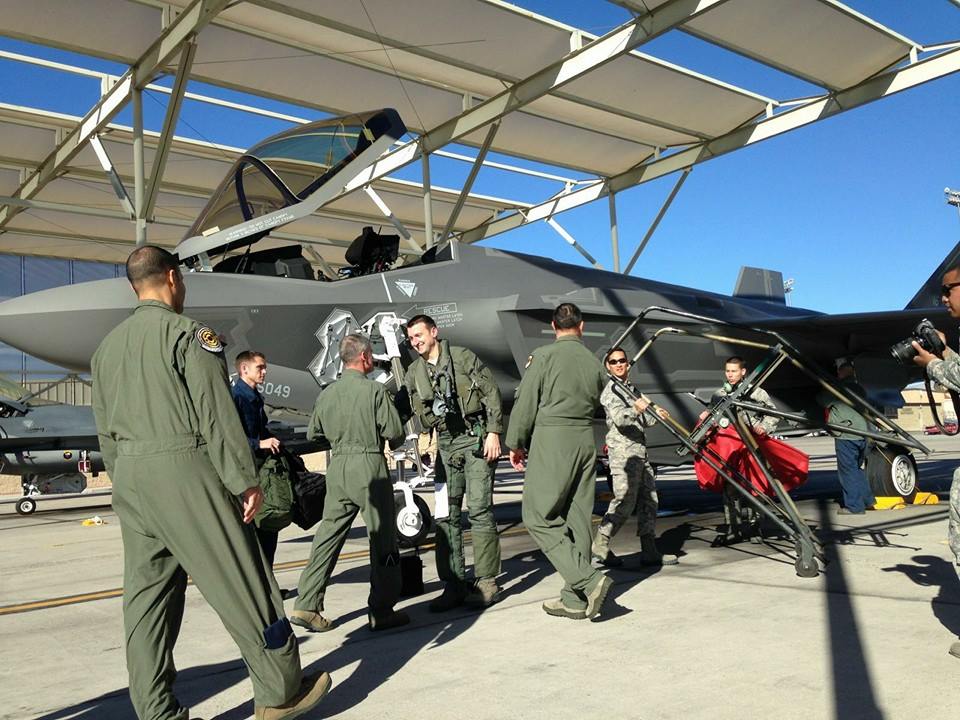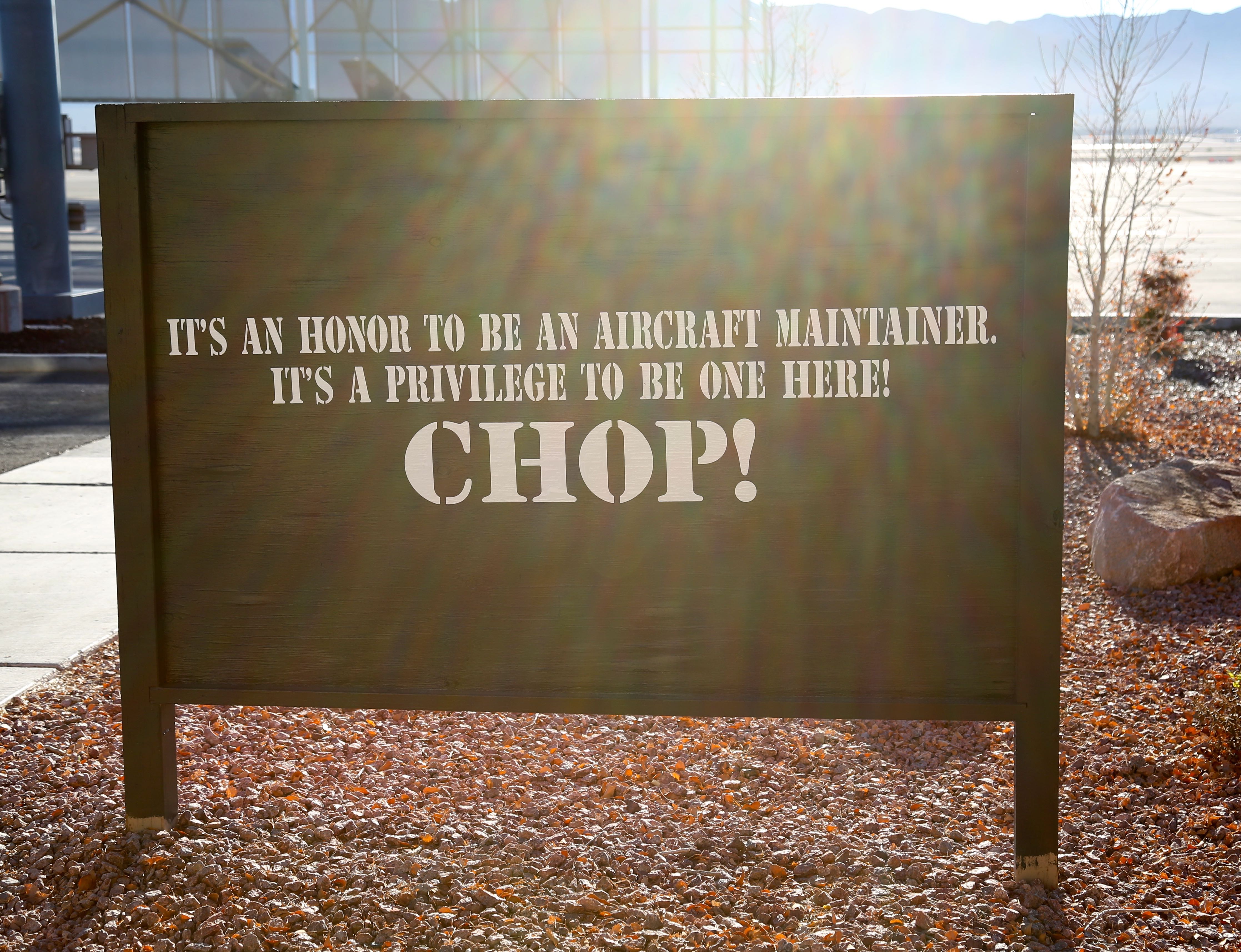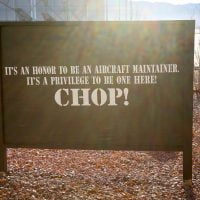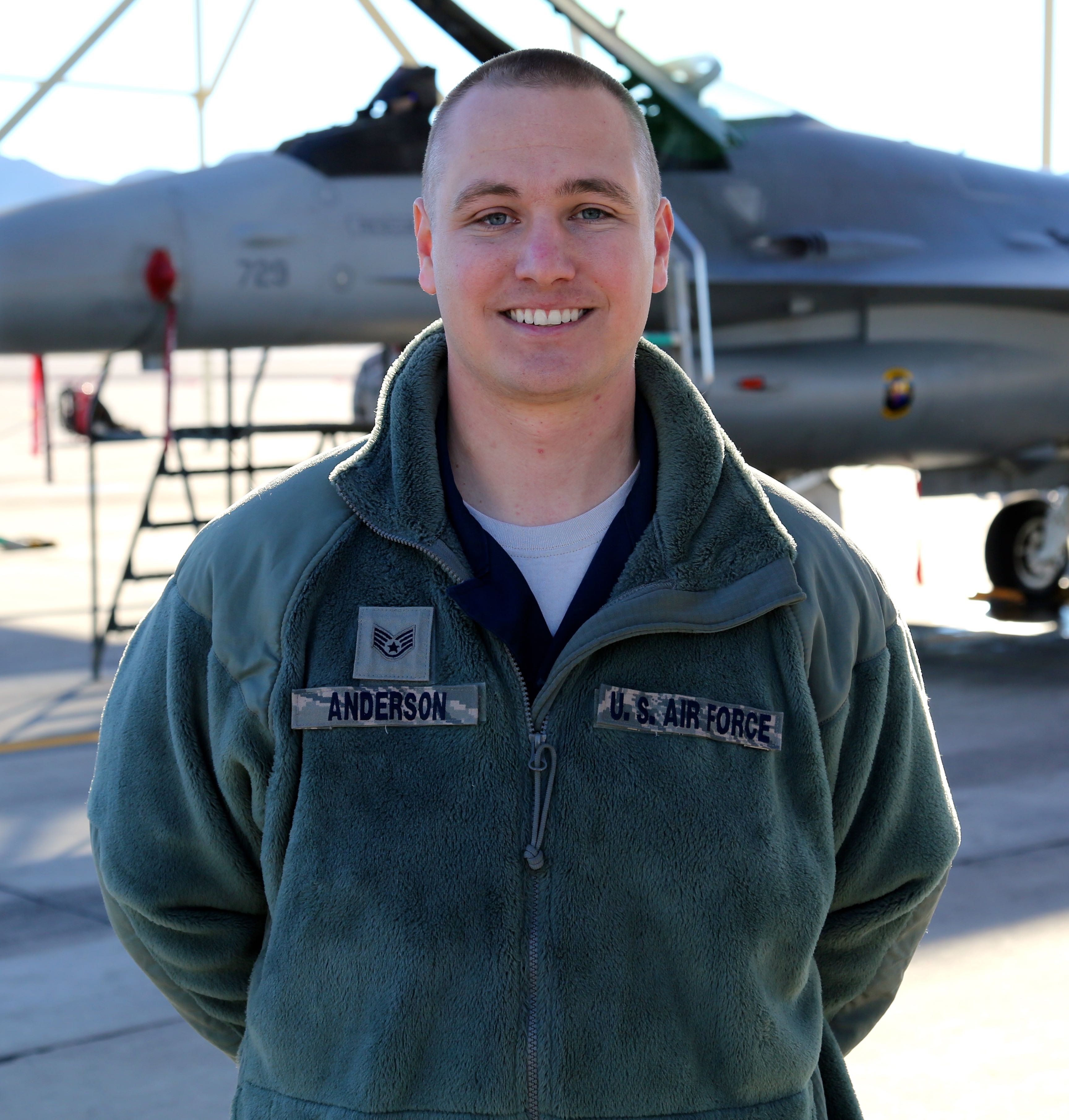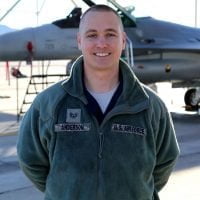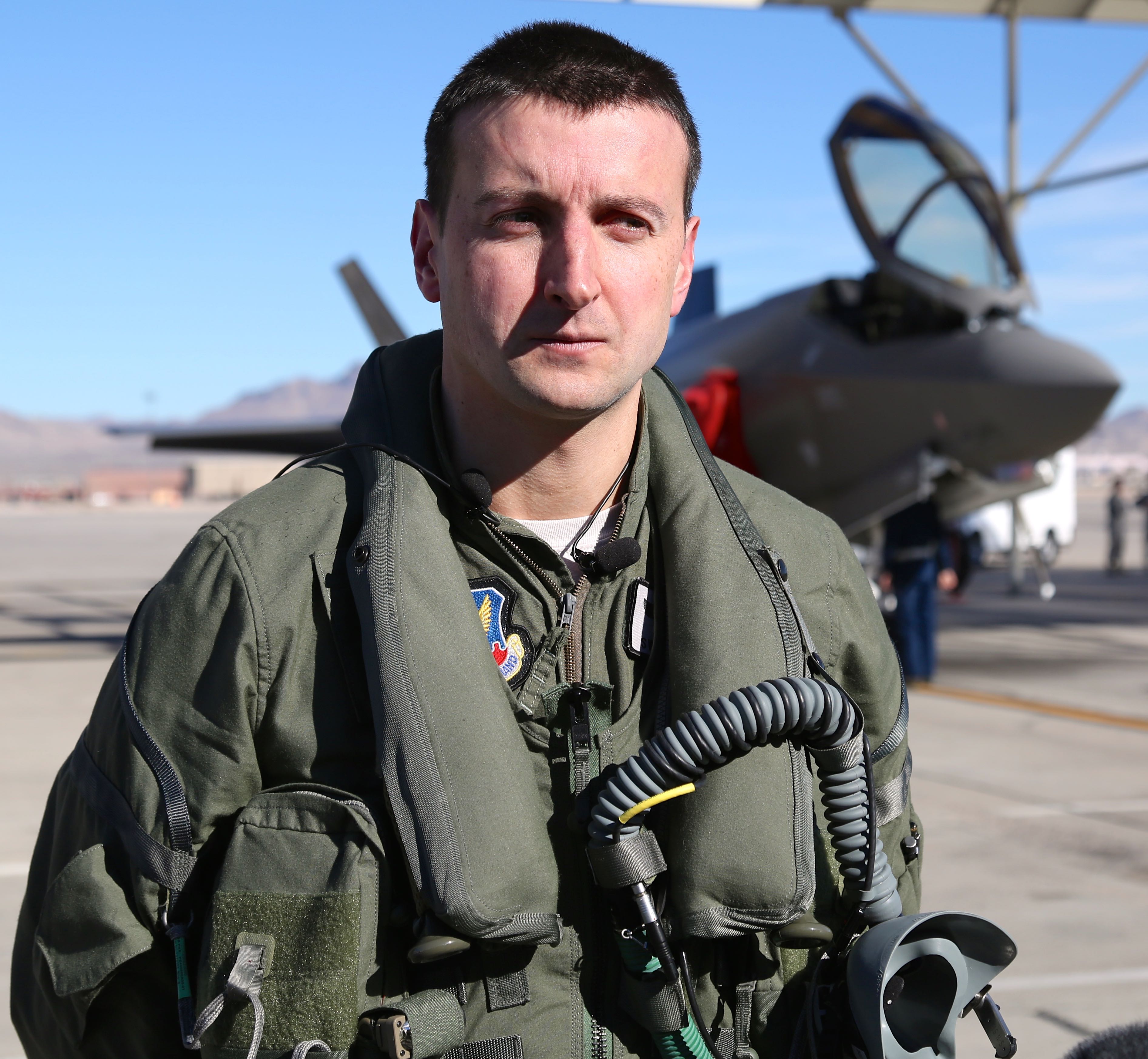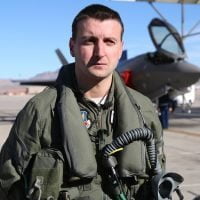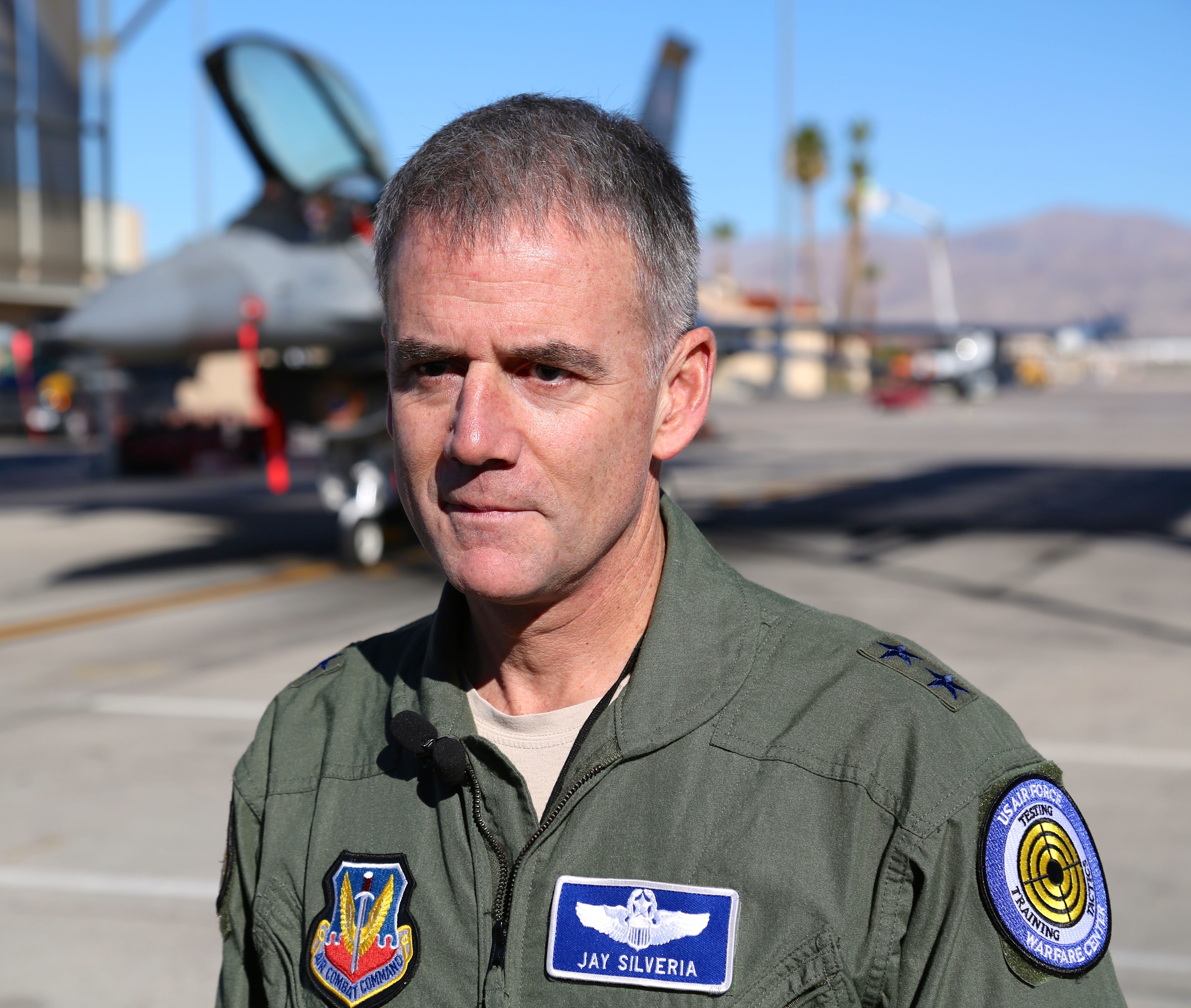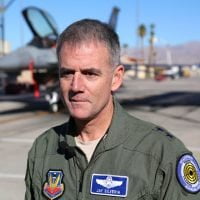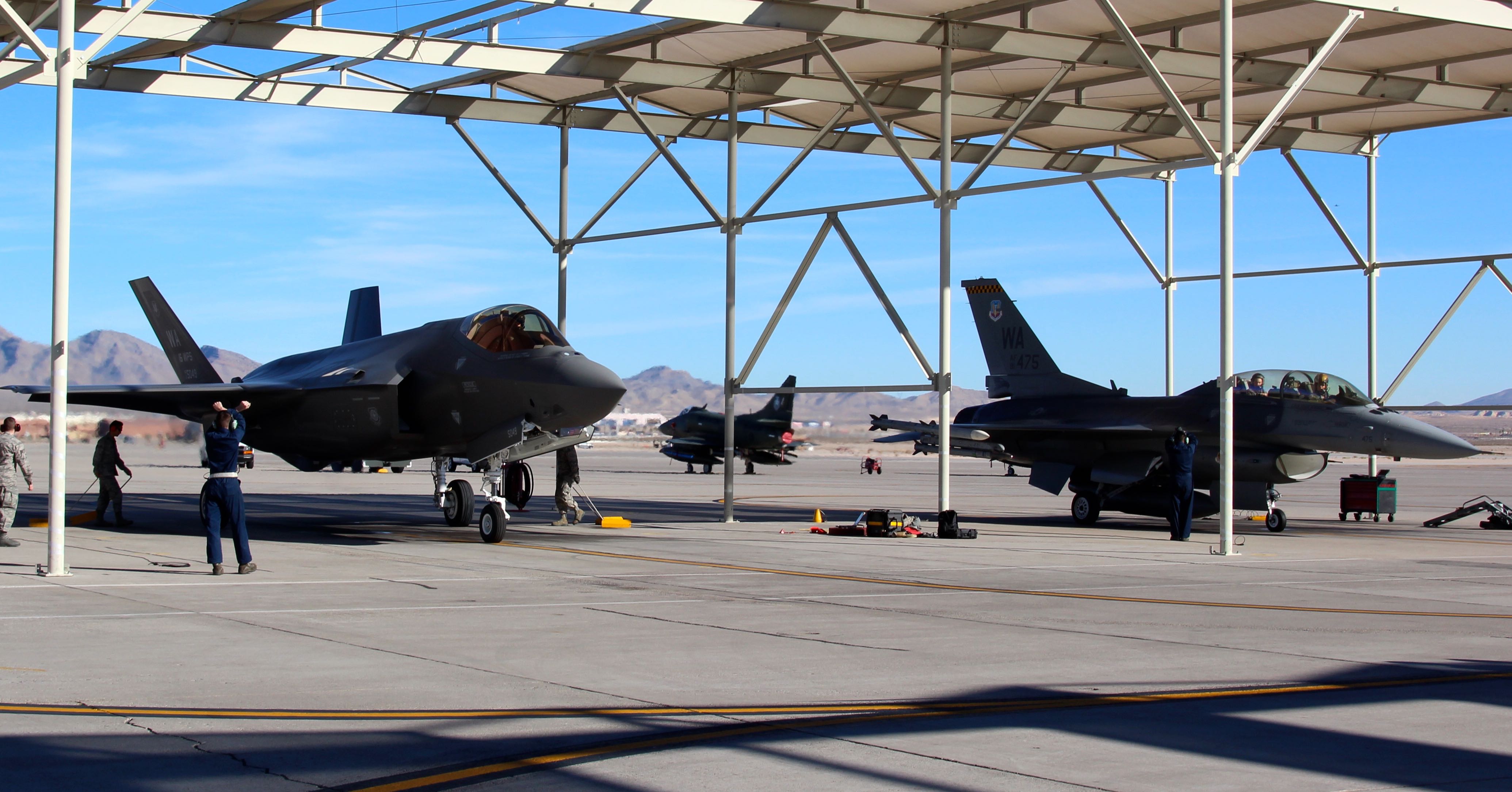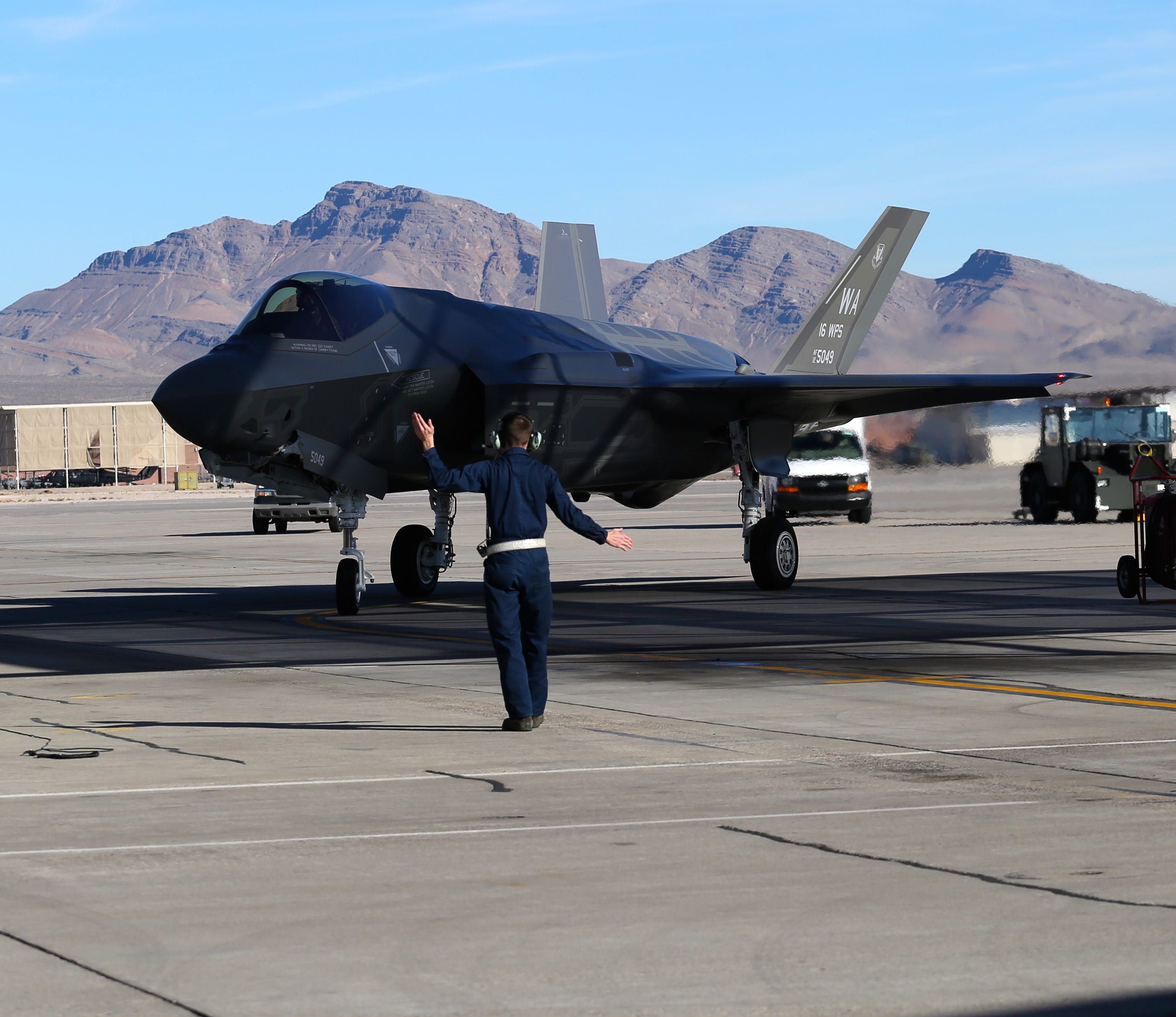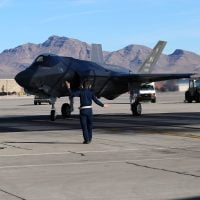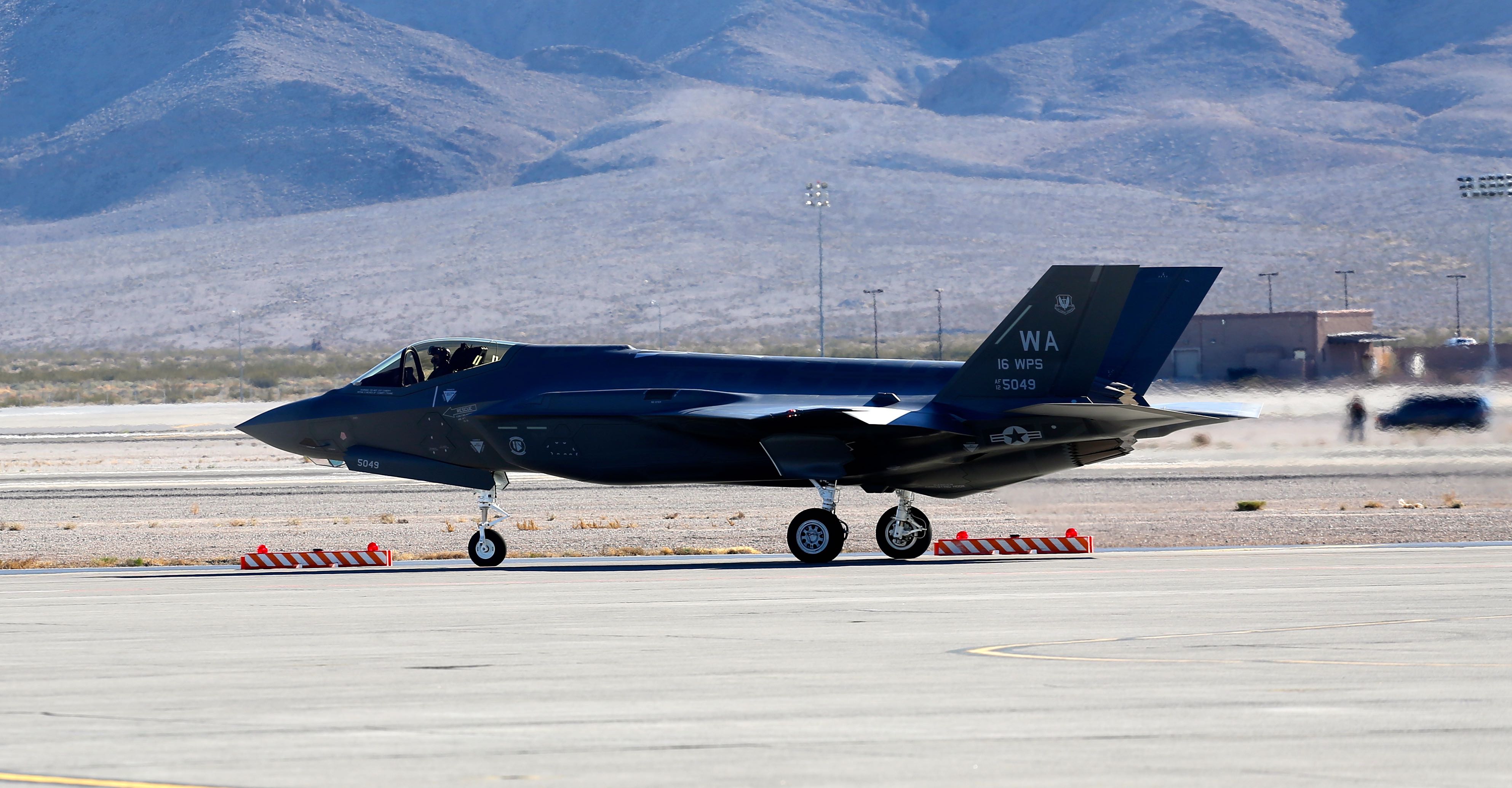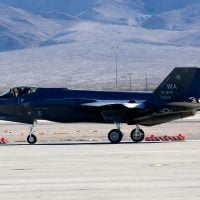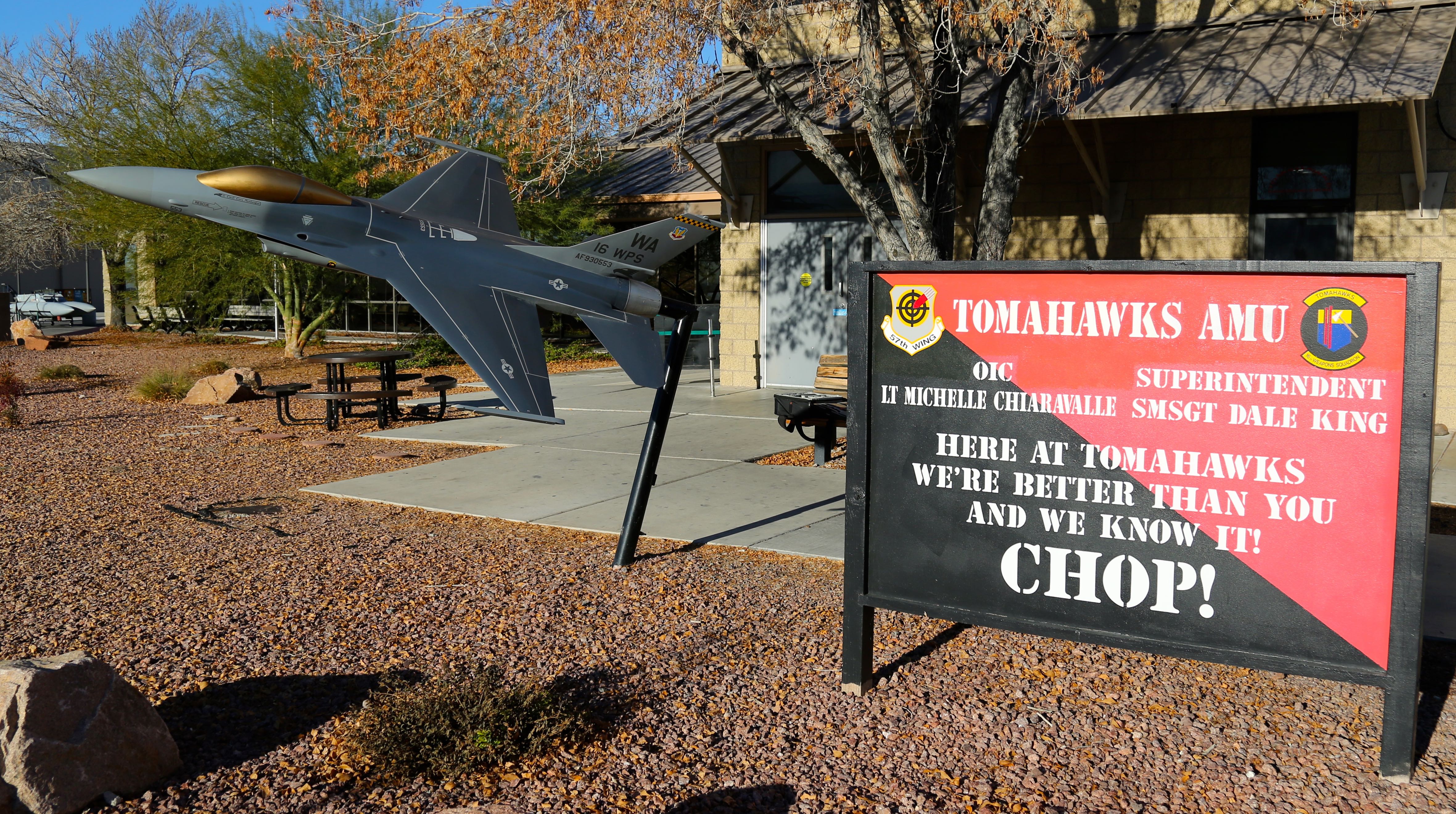2015-01-15 By Robbin Laird and Ed Timperlake
Nellis AFB, Nevada
A new chapter in developing the next generation of combat airpower has just opened at the USAF Weapons School, Nellis AFB.
We attended the arrival ceremony of the first fully operational F-35A into the USAF Weapons School.
F-35s have been flying with the 53rd Test and Evaluation Group.
But on a sunny Thursday morning January 15 the first tactical Lightning escorted by two Vipers landed and taxied in, thus beginning the tactical preparation for next year’s F-35A IOC entry into the USAF operational fleet.
According to a Nellis press release provided on January 14, 2015:
The F-35 arrival marks the first step in creating Weapons Officers who will build, teach and lead the Air Force’s F-35 community. These Block 3 aircraft will be used to advance the combat tactics development and train our Weapons School cadre as they create the F-35 Weapons Instructor Course.
Initially, the 16th Weapons Squadron will fly the F-35’s in concert with the 422nd Test and Evaluation Squadron to support the United States Air Force Warfare Center’s part in the initial operational test and evaluation program. Additionally, Weapons School missions will incorporate the F-35s to further develop integrated tactics in preparation for initial operational capability.
The arrival at Nellis AFB marks the next phase of the beginning of the introduction of the F-35A into USAF combat service.
The testing and training will continue but with an aircraft configured exactly like those to follow into initial operational capability (IOC).
IOC for the F-35 has to be placed in the overall context of how the U.S. services and allies are looking at their F-35s.
The IOC of the F-35 is not simply about the introduction of a replacement aircraft but the next phase in the revolution of airpower and inextricably intertwined with doing air combat differently.
In our discussions with the pilots, maintainers and industrialists involved in the launch of the F-35 worldwide, there is clear awareness that the F-35 is not simply about business as usual.
There is a clear sense of excitement seen by the F-35 launch cadre.
And each service or allied partner has a particular launch point with regard to transformation, which various Type/Model/Series of F-35s enables or facilitates.
The weapons school at Nellis is where it will happen for the F-35A.
This is not a replacement aircraft in and of itself, but rather it is the driving technology catalyst for a transformation of combat air power in this next phase of military aviation history.
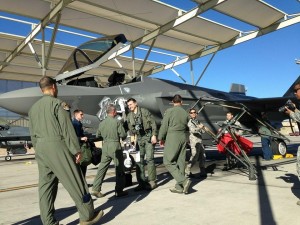
According to the fact sheet describing the important role of the USAF Air Warfare Center, the arrival of the first F-35A for the weapons school, falls in line with its identified core objectives:
Commander’s Vision and Mission
The mission of the U.S. Air Force Warfare Center is to develop innovative leaders and full spectrum capabilities through responsive, realistic, and relevant Air Force and joint testing development, and advanced training across all levels of war.
The U.S. Air Force Warfare Center’s vision is to maintain a team of innovative, highly skilled Airmen providing effective weapons, tactics, and command and control integrated across air, space and cyberspace for the Joint Force Commander.
Commander’s Priorities:
- Enable On-time F-35 Initial Operational Capability Declarations
- Maximize Testing, Tactics, and Training to Enhance Total Force Integration of Air, Space, and Cyberspace.
- Lead Implementation of Realistic and Relevant Live, Virtual, and Constructive Exercise and Training Across the Air Force and Joint Communities.
- Strengthen Joint Warfighting Capabilities and Thinking in a Contested, Degraded, and Operationally-Limited Environment.
In discussions at the ceremony highlighting the arrival of the F-35A to the weapons school, we spoke to the head of the air warfare center, the pilot who flew the plane from Fort Worth to Nellis, the commanding general of the Wing where the weapons school operates, and the F-35 Crew Chief. Each provided insights into how they see the transition and the importance of this historical moment.
More detailed interviews will be provided after our return from Nellis, but this day was an exciting one for the USAF here at Nellis and was clearly seen as marking an important step in the next phase of the USAF and its worldwide operations.
For Major General Silveria, the Commander of the USAF Warfare Center, a qualified F-35 pilot, the arrival of the aircraft to the weapons school marks a crucial moment in shaping the way ahead.
Having this aircraft at Nellis represents the beginning in the operational tests in earnest for the F-35 program and represents the beginning of tactical development of the F-35 at the weapons school.
We have some F-35s here in earlier configurations, but the plane, which landed today, is the plane we will go operational with. We need this aircraft and this configuration to shape the tactics in taking the aircraft into operation in 2016.
This is the first of many as more F35s will flow into Nellis this year and next. The pilot who has landed today is the first pilot in the 57th Wing in Nellis, which will be writing the syllabus for the Weapons School with the first pilots graduating from that program in 2018.
The Commander of the 57th Wing, Brigadier General Chris Short, highlighted that “today is very exciting for us. We are putting iron on the ramp and we can press on with taking this leading edge capability and integrating into the combat air force.”
He also highlighted the importance of a relationship with the USMC, the service that is first putting the F-35 into operation.
The pilot who flew the plane into Nellis was Captain Brent Golden. An F-15 strike eagle pilot with combat experience in operations in the Middle East, the Captain highlighted the importance his flying in the newly configured aircraft.
He emphasized that the work at Nellis is about getting the F-35 integrated into the combat air force. When a local reporter asked him what he meant by integration, he answered that he was not really focusing on the aircraft per se but on its impact on the evolution of the overall operational capabilities of the combat air force.
“We are focused not simply on the aircraft but on its integration within the entire battlespace.”
He emphasized that the integration of the plane into the weapons school was a microcosm of the integration of the plane within the combat air force overall.
Prior to the event, we had a chance to talk with one individual who makes it all happen for the combat pilots a fully trained F-35 Crew Chief.
Staff Sargent Jason Anderson is a dedicated crew chief on the F-35 with the 57th Wing, who earlier had been an F-15 crew chief and thent went to Eglin AFB to qualify on the F-35.
His well-qualified professional background in greeting the new F-35A reflected the importance of the commonality in the program.
Earlier, he had worked on F-35Bs at Eglin. He observed that the F-35B was an amazing technological achievement.
“I love the STOVL model. It is an amazing airplane and I worked on it for two months at Eglin.”
He is a combat airman with two tours in Afghanistan being based at Bagram.
He underscored the importance of the shift from the F-15 maintenance approach to that of the F-35 in terms of moving from gauges and many additional tools for maintenance to having a computer based maintenance approach.
He argued that this shift brings a much more efficient and accurate appraoch to maintaining the aircraft
“It is early days with the maintenance regime for the F-35, the way ahead is clear.
We hook up to a computer and we can see almost everything.
It eliminates a lot of the maintainer learned judgment that we had rely on from the maintainer side with the F-15 and it allows us to get maintainers up to speed much more rapidly and to build out a common computer data base for maintainers joining the team to draw upon as they get up to speed.”
The Crew Chief highlighted the importance of the new approach as well its symmetry with what is becoming known as I-Pad generation maintainers.
“This is exactly how it should be with a new aircraft.
The new guys can pick up quickly because of the approach.
We are writing the book, for we are correcting mistakes as we go along and changing the manuals.
But the impact can be significant of the new capabilities.
For example, the new guys were able to in one week were able to refuel aircraft themselves. “
The sense of excitement was palpable by all from the Commanding General to the pilots and maintainers making this historic day possible.
A page has been turned and the fighting air force is working towards a more effective combat force going forward, under the impact of the F-35 and its capabilities.
What follows are useful Nellis links to various key commands and persons involved with the F-35 integration in the combat air force:
http://www.nellis.af.mil/library/factsheets/factsheet.asp?id=4082
http://www.nellis.af.mil/library/factsheets/factsheet.asp?id=4098
http://www.nellis.af.mil/library/factsheets/factsheet.asp?id=4100
http://www.505ccw.acc.af.mil/library/factsheets/factsheet.asp?id=15206
http://www.505ccw.acc.af.mil/shared/media/document/AFD-130730-026.pdf
http://www.nellis.af.mil/library/factsheets/factsheet.asp?id=19160
http://www.nellis.af.mil/library/biographies/bio.asp?id=17532
http://www.nellis.af.mil/library/factsheets/factsheet.asp?id=18506
Several media pieces highlighted various aspects of today’s events and excerpts are provided along with the links below:
From a piece by Keith Rogers published in the Las Vegas Review Journal:
The Lightning has landed.
Nellis Air Force Base received its first F-35 Lightning II joint strike fighter jet Thursday for the United States Air Force Weapons School, part of the 57th Wing at Nellis.
The stealthy gray jet, which arrived at 9:38 a.m. from Lockheed Martin’s production plant in Fort Worth, Texas, was escorted by two F-16s from the 57th Wing.
It will be used by a cadre of experienced pilots for doctorate-level training to develop and validate the combat tactics playbook for the high-tech F-35.
Capt. Brent Golden said after flying more than 900 miles in about two hours — cruising at about 8 miles per minute — that he was awestruck when he looked down and saw the Las Vegas Valley.
“It was a pretty amazing feeling,” the 32-year-old pilot said, standing in front of the F-35 after he parked it under a shade structure on the Nellis ramp.
“It was a pretty impressive sight to see the entire Vegas Strip there in front of me,” he said.
“It was a very special feeling. I was very proud and it was very humbling.”
Golden, a native of Philadelphia who has flown F-15 Strike Eagles on combat missions, said the F-35 is a smooth-flying jet.
It has multifaceted capability to fuse many streams of flight information simultaneously that “reduces the pilot workload significantly.”
From a piece by Denise Wong reporting for local TV station KTNV:
History was made Thursday morning at Nellis Air Force Base as the first F-35 fighter jet that will be used at the weapons school touched down.
“This is happening,” said Brigadier General Chris Short, 57th Wing Commander.
“And to put iron on the ramp, it’s exciting…..”
The one that landed at Nellis will be used to train the next generation of fighter pilots in the valley. Pilots will also get to test out what the aircraft is truly capable of.
“So we’re going to test it, we’re going to run it out, we’re going to run it out on the Nellis ranges,” said Major General Jay Silveria, Warfare Center Commander at Nellis AFB. “We’re going to get everything we can out of this airplane.”
They’re going to develop tactics to make this the war-fighting machine it’s meant to be.
“It’s an incredibly smooth aircraft to fly. I found it’s really easy to fly,” said Capt. Brent Golden, who flew the aircraft in from Dallas just a few hours before. He praised the F-35’s capability to share information with other aircraft, which will make flying in combat that much better for pilots.
“So it reduces the pilot workload significantly,” said Capt. Golden. “And it really allows us to really concentrate on the flying piece and make decisions a lot faster because you have information like that more readily available to you.”
He should know. He’s been in combat before.
And according to The Global Aviation Report:
A new era began at the U.S. Air Force Weapons School when its first F-35A Lightning II touched-down on the flightline here Jan. 15, flown straight from the Lockheed Martin plant in Fort Worth, Texas.
Working in conjunction with the U.S. Air Force Warfare Center and 422nd Test and Evaluation Squadron, Col. Adrian Spain, USAFWS commandant, said the Weapons School’s first F-35 will be used to drive tactics development and that the Weapons School’s immediate goal is to create the curriculum for the first F-35 course.
“That’s going to be the initial focus over the next year,” Spain said.
“Certainly in the next year-and-a-half or so, we will be far enough along in continuing [tactics development] to develop a weapons school syllabus for the F-35 … in the next two years, we’ll be transitioning pilots in the short term to get F-35 experience, but we’ll also be developing the [combat air forces] syllabus.”
The arrival and integration of the F-35 into the Weapons School is a natural evolution toward the Air Force’s desired force mixture and will have far-reaching effects, explained Spain.
“The addition of the F-35 is something that is unquestionable in terms of its impact on the rest of the Air Force and our ability to wage war in a modern battle space,” Spain said.
“Because it’s the latest fighter we have in our inventory, those capabilities need to be integrated as quickly as possible and as efficiently as possible, so the rest of the field knows how to go to war with it, if it’s ever called upon.”
The slideshow above are photos shot on January 15, 2015 at the arrival of the F-35A at Nellis.
The first photo shows the location of the landing which was at the Thunderbirds Maintenance facility at Nellis.
The second and third photos show the land arriving and then turning into its hanger.
The fourth photo shows the plane in its hanger
The fifth photo shows Major General Silveria; the sixth Brigadier General Short; the seventh the pilot, Captain Golden, the eighth crew chief Anderson and the final photo shows us a reminder of who makes the enterprise run at the airbase.
The photos are credited to Second Line of Defense.


